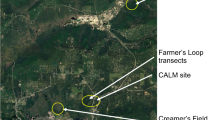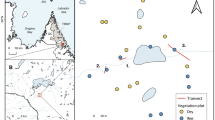Abstract
Vegetation, active-layer soils, and snow cover regulate energy exchange between the atmosphere and permafrost. Therefore, interactions between changes to tundra vegetation and soil thermal regime will fundamentally affect permafrost in a warmer world. We recorded soil temperatures for approximately 1 year in a Siberian Low Arctic landscape with a known history of alder (Alnus) shrub expansion on disturbed microsites in patterned ground. We recorded near-surface soil temperatures and measured physical properties of soils and vegetation on sorted-circle microsites in four stages of shrubland development: (1) tundra lacking tall shrubs; (2) shrub colonization zones; (3) mature shrublands; and (4) paludified, long-established shrublands with thick soil organic layers. Summer soil temperatures declined with increasing shrub cover and soil organic thickness; shrub colonization suppressed cryoturbation, facilitating the development of continuous vegetation and a surface organic mat on circles. Compared to open tundra, mature shrubs cooled soils by up to 9 °C during summer, but warmed soils by greater than 10 °C in winter presumably because they developed highly insulative snowpacks. Paludified shrublands had the coldest summer active layers, but winter soil temperatures were much colder than mature shrublands and were similar to earlier stages. Our results indicate that although tall shrub establishment dramatically warms winter soils within decades, much of this warming is transient at paludification-prone sites because the buildup of wet peat favors cooling in winter and the stature and snow-trapping capacity of shrubs diminish over time. In the ecosystem we studied, shrub expansion has contrasting effects on active-layer temperatures both seasonally and over longer timescales due to successional processes.








Similar content being viewed by others

References
Blok D, Heijmans MMPD, Schaepman-Strub G, Kononov AV, Maximov TC, Berendse F. 2010. Shrub expansion may reduce summer permafrost thaw in Siberian tundra. Glob Change Biol 16:1296–305.
Blok D, Heijmans MMPD, Schaepman-Strub G, van Ruijven J, Parmentier FJW, Maximov TC, Berendse F. 2011. The cooling capacity of mosses: controls on water and energy fluxes in a Siberian tundra site. Ecosystems 14:1055–65.
Bonfils CJW, Phillips TJ, Lawrence DM, Cameron-Smith P, Riley WJ, Subin ZM. 2012. On the influence of shrub height and expansion on northern high latitude climate. Environ Res Lett 7:015503.
Brown J, Ferrians OJJ, Heginbottom JA, Melnikov ES. 2001. Circum-arctic map of permafrost and ground ice conditions. Version 2. National Snow and Ice Data Center. URL: http://nsidc.org/data/GGD318.
Buckeridge KM, Zufelt E, Chu H, Grogan P. 2010. Soil nitrogen cycling rates in low arctic shrub tundra are enhanced by litter feedbacks. Plant Soil 330:407–21.
Cahoon SMP, Sullivan PF, Shaver GR, Welker JM, Post E. 2012. Interactions among shrub cover and the soil microclimate may determine future Arctic carbon budgets. Ecol Lett 15:1415–22.
CAVM Team. 2003. Circumpolar arctic vegetation map (1:7,500,000 scale). Conservation of Arctic Flora and Fauna (CAFF) Map No. 1. Anchorage (AK): U.S. Fish and Wildlife Service.
Chapin FS, Sturm M, Serreze MC, McFadden JP, Key JR, Lloyd AH, McGuire AD, Rupp TS, Lynch AH, Schimel JP, Beringer J, Chapman WL, Epstein HE, Euskirchen ES, Hinzman LD, Jia GJ, Ping CL, Tape KD, Thompson CDC, Walker DA, Welker JM. 2005. Role of land-surface changes in arctic summer warming. Science 310:657–60.
Elmendorf SC, Henry GHR, Hollister RD, Björk RG, Bjorkman AD, Callaghan TV, Collier LS, Cooper EJ, Cornelissen JHC, Day TA, Fosaa AM, Gould WA, Grétarsdóttir J, Harte J, Hermanutz L, Hik DS, Hofgaard A, Jarrad F, Jónsdóttir IS, Keuper F, Klanderud K, Klein JA, Koh S, Kudo G, Lang SI, Loewen V, May JL, Mercado J, Michelsen A, Molau U, Myers-Smith IH, Oberbauer SF, Pieper S, Post E, Rixen C, Robinson CH, Schmidt NM, Shaver GR, Stenström A, Tolvanen A, Totland Ø, Troxler T, Wahren C-H, Webber PJ, Welker JM, Wookey PA. 2012. Global assessment of experimental climate warming on tundra vegetation: heterogeneity over space and time. Ecol Lett 15:164–75.
Fisher JP, Estop-Aragonés C, Thierry A, Charman DJ, Wolfe SA, Hartley IP, Murton JB, Williams M, Phoenix GK. 2016. The influence of vegetation and soil characteristics on active-layer thickness of permafrost soils in boreal forest. Glob Change Biol 22:3127–40.
Forbes BC, Macias-Fauria M, Zetterberg P. 2010. Russian Arctic warming and ‘greening’ are closely tracked by tundra shrub willows. Glob Change Biol 16:1542–54.
Fraser RH, Lantz TC, Olthof I, Kokelj SV, Sims RA. 2014. Warming-induced shrub expansion and lichen decline in the western Canadian Arctic. Ecosystems 17:1151–68.
Frost GV, Epstein HE. 2014. Tall shrub and tree expansion in Siberian tundra ecotones since the 1960s. Glob Change Biol 20:1264–77.
Frost GV, Epstein HE, Walker DA, Matyshak G, Ermokhina K. 2013. Patterned-ground facilitates shrub expansion in Low Arctic tundra. Environ Res Lett 8:15035.
Frost GV, Epstein HE, Walker DA, Matyshak G, Ermokhina KA. 2012. Data report of the 2011 expedition to Kharp, southern Yamal Peninsula region, Russia. Fairbanks (AK): University of Alaska Fairbanks. www.geobotany.org/library/reports/FrostGV2012_yamal_dr20121030.pdf.
Goodrich LE. 1982. The influence of snow cover on the ground thermal regime. Can Geotech J 19:421–32.
Jorgenson MT, Roth JE, Miller PF, Macander MJ, Duffy MS, Wells AF, Frost GV, Pullman ER. 2009. An ecological land survey and landcover map of the Arctic Network. Fort Collins (CO): U.S. Department of the Interior.
Juszak I, Erb AM, Maximov TC, Schaepman-Strub G. 2014. Arctic shrub effects on NDVI, summer albedo and soil shading. Remote Sens Environ 153:79–89.
Kade A, Romanovsky VE, Walker DA. 2006. The n-factor of nonsorted circles along a climate gradient in Arctic Alaska. Permafr Periglac Process 17:279–89.
Kade A, Walker DA, Raynolds MK. 2005. Plant communities and soils in cryoturbated tundra along a bioclimate gradient in the Low Arctic, Alaska. Phytocoenologia 35:761–820.
Karunaratne KC, Burn CR. 2004. Relations between air and surface temperature in discontinuous permafrost terrain near Mayo, Yukon Territory. Can J Earth Sci 41:1437–51.
Klene AE, Nelson FE, Shiklomanov NI. 2001. The n-factor as a tool in geocryological mapping: seasonal thaw in the Kuparuk River basin, Alaska. Phys Geogr 22:449–66.
Kokelj SV, Lantz TC, Wolfe SA, Kanigan JC, Morse PD, Coutts R, Molina-Giraldo N, Burn CR. 2014. Distribution and activity of ice wedges across the forest-tundra transition, western Arctic Canada: ice wedges across tree line. J Geophys Res Earth Surf 119:2032–47.
Lantz TC, Gergel SE, Henry GHR. 2010. Response of green alder (Alnus viridis subsp. fruticosa) patch dynamics and plant community composition to fire and regional temperature in north-western Canada. J Biogeogr 37:1597–610.
Lantz TC, Kokelj SV, Gergel SE, Henry GHR. 2009. Relative impacts of disturbance and temperature: persistent changes in microenvironment and vegetation in retrogressive thaw slumps. Glob Change Biol 15:1664–75.
Lantz TC, Marsh P, Kokelj SV. 2012. Recent shrub proliferation in the Mackenzie Delta uplands and microclimatic implications. Ecosystems 16:47–59.
Lawrence DM, Swenson SC. 2011. Permafrost response to increasing Arctic shrub abundance depends on the relative influence of shrubs on local soil cooling versus large-scale climate warming. Environ Res Lett 6:45504.
Makoto K, Klaminder J. 2012. The influence of non-sorted circles on species diversity of vascular plants, bryophytes and lichens in Sub-Arctic Tundra. Polar Biol 35:1659–67.
Matyshak GV, Goncharova OY, Moskalenko NG, Walker DA, Epstein HE, Shur Y. 2015. Contrasting soil thermal regimes in the forest-tundra transition near Nadym, West Siberia, Russia: Nadym soil thermal regimes. Permafr Periglac Process. doi:10.1002/ppp.1882.
McManus KM, Morton DC, Masek JG, Wang D, Sexton JO, Nagol JR, Ropars P, Boudreau S. 2012. Satellite-based evidence for shrub and graminoid tundra expansion in northern Quebec from 1986 to 2010. Glob Change Biol 18:2313–23.
Myers-Smith IH, Elmendorf SC, Beck PSA, Wilmking M, Hallinger M, Blok D, Tape KD, Rayback SA, Macias-Fauria M, Forbes BC, Speed JDM, Boulanger-Lapointe N, Rixen C, Lévesque E, Schmidt NM, Baittinger C, Trant AJ, Hermanutz L, Collier LS, Dawes MA, Lantz TC, Weijers S, Jørgensen RH, Buchwal A, Buras A, Naito AT, Ravolainen V, Schaepman-Strub G, Wheeler JA, Wipf S, Guay KC, Hik DS, Vellend M. 2015. Climate sensitivity of shrub growth across the tundra biome. Nat Clim Change 5:887–91.
Myers-Smith IH, Hik DS. 2013. Shrub canopies influence soil temperatures but not nutrient dynamics: an experimental test of tundra snow-shrub interactions. Ecol Evol 3:3683–700.
Myers-Smith IH, Forbes BC, Wilmking M, Hallinger M, Lantz T, Blok D, Tape KD, Macias-Fauria M, Sass-Klaassen U, Lévesque E, Boudreau S, Ropars P, Hermanutz L, Trant A, Collier LS, Weijers S, Rozema J, Rayback SA, Schmidt NM, Schaepman-Strub G, Wipf S, Rixen C, Ménard CB, Venn S, Goetz S, Andreu-Hayles L, Elmendorf S, Ravolainen V, Welker J, Grogan P, Epstein HE, Hik DS. 2011. Shrub expansion in tundra ecosystems: dynamics, impacts and research priorities. Environ Res Lett 6:45509.
Nauta AL, Heijmans MMPD, Blok D, Limpens J, Elberling B, Gallagher A, Li B, Petrov RE, Maximov TC, van Huissteden J, Berendse F. 2014. Permafrost collapse after shrub removal shifts tundra ecosystem to a methane source. Nat Clim Change 5:67–70.
Paradis M, Lévesque E, Boudreau S. 2016. Greater effect of increasing shrub height on winter versus summer soil temperature. Environ Res Lett 11:085005.
Peterson RA, Krantz WB. 2003. A mechanism for differential frost heave and its implications for patterned-ground formation. J Glaciol 49:69–80.
Shur YL, Jorgenson MT. 2007. Patterns of permafrost formation and degradation in relation to climate and ecosystems. Permafr Periglac Process 18:7–19.
Sturm M, Douglas T, Racine C, Liston GE. 2005a. Changing snow and shrub conditions affect albedo with global implications. J Geophys Res 110:G01004.
Sturm M, Schimel J, Michaelson G, Welker JM, Oberbauer SF, Liston GE, Fahnestock J, Romanovsky VE. 2005b. Winter biological processes could help convert arctic tundra to shrubland. BioScience 55:17–26.
Sturm M, Holmgren J, McFadden JP, Liston GE, Chapin FSIII, Racine CH. 2001. Snow-shrub interactions in Arctic tundra: a hypothesis with climatic implications. J Clim 14:336–44.
Sutton JT, Hermanutz L, Jacobs JD. 2006. Are frost boils important for the recruitment of arctic-alpine plants? Arct Antarct Alp Res 38:273–5.
Swanson DK. 2015. Environmental limits of tall shrubs in Alaska’s Arctic National Parks. PloS One 10:e0138387.
Tape K, Sturm M, Racine C. 2006. The evidence for shrub expansion in northern Alaska and the Pan-Arctic. Glob Change Biol 12:686–702.
Tape KD, Gustine DD, Ruess RW, Adams LG, Clark JA. 2016. Range expansion of moose in arctic Alaska linked to warming and increased shrub habitat. PloS One 11:e0152636.
Tape KD, Hallinger M, Welker JM, Ruess RW. 2012. Landscape heterogeneity of shrub expansion in arctic Alaska. Ecosystems 15:711–24.
Tyrtikov AP. 1959. Perennially frozen ground and vegetation. In: Principles of geocryology. Technical translation. Ottawa, Canada: National Research Council of Canada. pp 399–421.
Washburn AL. 1980. Geocryology: a survey of periglacial processes and environments. Hoboken (NJ): Wiley.
Zhang T. 2005. Influence of the seasonal snow cover on the ground thermal regime: an overview. Rev Geophys 43:RG4002.
Zhu Z, Woodcock CE. 2014. Automated cloud, cloud shadow, and snow detection in multitemporal Landsat data: an algorithm designed specifically for monitoring land cover change. Remote Sens Environ 152:217–34.
Acknowledgements
This work was funded by NASA Land-Cover and Land-Use Change (LCLUC) grants NNG6GE00A, NNX09AK56G, and NNX14AD906 and NSF ARCSS Seasonality grant ARC-0902152. Additional funding was also provided by the Department of Environmental Sciences at the University of Virginia and the Virginia Space Grant Consortium. Alex Prichard and Matthew Macander (ABR, Inc.—Environmental Research & Services) provided valuable input on the soil temperature data analysis and remote sensing of snow. We also thank Anna Bobrik, Olga Goncharova, Olga Ogneva, and Matvey Tarkhov at Moscow State University for their essential assistance in the field studies at Kharp.
Author information
Authors and Affiliations
Corresponding author
Additional information
Authors’ contributions
GVF, HEE, and DAW conceived the study. GVF, HEE, GM, and KE collected and analyzed the field data. GVF wrote the paper with contributions from HEE, DAW, and GM.
Electronic supplementary material
Below is the link to the electronic supplementary material.
Rights and permissions
About this article
Cite this article
Frost, G.V., Epstein, H.E., Walker, D.A. et al. Seasonal and Long-Term Changes to Active-Layer Temperatures after Tall Shrubland Expansion and Succession in Arctic Tundra. Ecosystems 21, 507–520 (2018). https://doi.org/10.1007/s10021-017-0165-5
Received:
Accepted:
Published:
Issue Date:
DOI: https://doi.org/10.1007/s10021-017-0165-5



